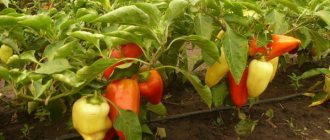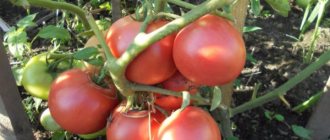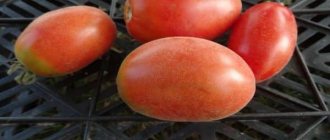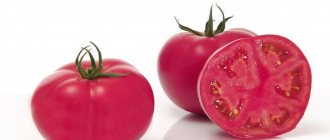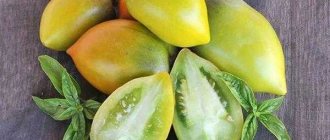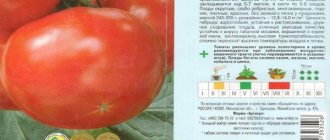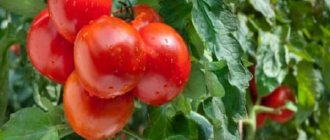Tomato Ilya Muromets fully lives up to its name. Like a hero from Russian epics, he is tall, powerful, with large, heavy fruits. The cultivar was bred agro (Moscow region), included in the register of varieties recommended for cultivation in 2008. Approved for cultivation in all regions.
| Height | Landing location | Ripening time | Fruit color | Fruit size | Origin | Fruit shape |
| Tall | Open ground | Mid-season | Yellow | Large | Variety | Flat-round |
General description of the variety
Ilya Muromets is a tomato variety bred by domestic breeders. It was registered and entered into the Russian state register.
Note! Seeds collected from the harvest of Ilya Muromets are suitable for planting. There are not many of them in the fruits - in order to obtain a sufficient amount of planting material, 4-5 of the largest tomatoes are left on the bushes until they are fully ripe.
Distinctive features
Ilya Muromets is a yellow-fruited tomato. It produces large tomatoes, orange on the outside and yellow on the inside. Look what this variety looks like in the photo.
The taste of the fruit is sweet and sour, the aroma is rich tomato. The pulp is dense but juicy.
A characteristic feature of the variety is a small number of seeds. This improves the taste of tomatoes, but makes it difficult to collect planting material.
The tomato is suitable for growing in greenhouses and open ground. Gardeners who planted it note that in the second case the taste is more intense.
Has high immunity to viral diseases of tomatoes. Resistance to fungal infections is not so high. Tomatoes sometimes suffer from late blight.
One of the negative features of the variety is its high susceptibility to waterlogging. In such conditions, the roots begin to rot and the bushes shed their leaves.
Note ! The more sunlight the tomatoes receive, the richer the aroma and sweeter the fruit will taste.
Main characteristics
It is precisely for his characteristics that Ilya Muromets fell in love with gardeners in all countries of the former CIS. The description of the tomato suggests that with high yields it requires minimal care:
| Parameter | Indicators |
| Bush type | Indeterminate. It reaches a height of 0.8-2 m. In a greenhouse, the bushes are taller. The stems are powerful and durable. The leaves are simple, deep green in color, and medium in size. The bushes are covered with an average amount of greenery and branch slightly. The inflorescences are simple. The first is formed in the axil of 5-7 leaves, the next - after 1-2 leaves. Fruits are formed in clusters of 5-7 pcs. |
| Growing method | It is resistant to frost. In all regions it is grown both in open ground and in greenhouses |
| Productivity | High. About 4 kg of fruits are collected from the bush. From 1 sq. m get up to 12 kg of harvest |
| Fruit | Large ones. The weight of each varies between 200-300 g. The skin color is yellow or orange, the inside of the tomatoes is yellow. There is no green spot at the base. The shape of the fruit is round, leveled, flattened at the base. There is mild ribbing. The skin is glossy. The taste is sweet and sour, with a rich tomato aroma. There is a lot of pulp, it is dense, but not hard. The concentration of dry matter does not exceed 6%, and sugars – 3.5%. Chambers with a small number of seeds - from 5 to 8 in each fruit |
| Transportability | High. Tomatoes are transported long distances and stored for more than a month |
| Ripening time | Mid-season. The first harvest is harvested 100-110 days after sowing the seeds |
| Disease resistance | Is immune to tomato diseases |
Description of mid-early tomato Ilya Muromets and agricultural cultivation technology
The mid-early tomato Ilya Muromets belongs to the selection of Russian agrobiologists and is intended for cultivation in open ground and greenhouses. Large fruits of bright yellow color are distinguished by their taste and universal use in cooking.
Advantages of the variety
The Ilya Muromets tomato is intended for cultivation in open and protected ground conditions. A variety with an average ripening period begins to bear fruit 95-108 days after germination.
Bushes of indeterminate type, with a moderate amount of foliage, during the growing season reach a height of 200 cm in a greenhouse, 80 cm in open ground. Medium sized leaves
Productivity depends on growing conditions. When cultivated in a greenhouse, 10-11 kg of fruit can be harvested from 1 m²; in open ground conditions, the yield per unit area is 6-8 kg of tomato.
The flowers of the plant are simple in shape, 5-6 fruits ripen in a cluster, uniform in color, without a spot near the stalk. Tomatoes are round in shape, smooth, with a glossy surface, standard size.
The weight of tomatoes reaches 230-350 g. By removing part of the ovary, larger fruits can be obtained. At the stage of technical ripeness, tomatoes acquire a bright yellow color. Tomatoes have juicy pulp with a dense consistency and rich flavor. The chambers with seeds are not clearly defined, there are few seeds.
The inside of the fruit is almost orange in color. Tomatoes contain more than 5% dry matter and 3.5-4% sugars. Tomatoes retain their shape even when canned in slices.
In cooking, the fruits are used fresh, for canning, and processing. The fruits are distinguished by the possibility of long-term storage and tolerate transportation well over distances.
The characteristics and description of the variety indicate the resistance of the crop to a complex of fungal and viral diseases. Tomato tolerates high soil and air temperatures well.
Agricultural technology for tomato cultivation
Growing the Ilya Muromets variety involves a system of agrotechnical measures applied to other tomatoes. Fruits from protected soil are less tasty. Tomatoes grown in open ground have an intense aroma and deep orange color.
When growing the variety, the seedling method is used. Sowing seeds for seedlings is carried out 55-65 days before planting in a permanent place. Before planting in the ground, it is recommended to treat the seeds with a growth stimulant to increase the plant’s immunity.
A soil mixture or substrate is poured into the containers, lightly compacted, grooves 1 cm deep are made. Seeds are placed in them at a distance from each other. After watering with warm water, cover the container with glass and leave until the sprouts hatch.
After this, the cover is removed and the container is placed in a well-lit place. Watering is carried out as the top layer of soil dries
During the growing period, it is important to provide the seedlings with optimal temperature conditions and to fertilize them with complex fertilizers according to the manufacturer’s scheme
At the stage of formation of 2 true leaves, picking is carried out in separate containers. For this purpose, you can use peat pots, with which the formed seedlings are subsequently transferred to a permanent place.
When picking, you can cull weak plants. Tomatoes with 1 flower cluster formed are planted in the ground. The distance between bushes should be 50 cm. It is recommended to place 4 plants per 1 m².
To increase the yield of the crop, the bushes are grown in 3-4 stems. To extend the growing season in open ground conditions, portable shelters are used. They are installed in the spring for periods of low temperatures at night.
To ensure uniform distribution of water during irrigation, it is recommended to use the drip irrigation method. You can prevent the surface layer of soil from drying out by mulching. For this event, non-woven black fiber or organic materials are used.
How to grow seedlings
Seeds for seedlings are sown in March in the central and southern regions, in early April - in regions with a northern climate. The cooler the weather, the later they begin to grow seedlings.
Mid-early varieties are not grown by seed. In this case, their harvest does not have time to ripen before the first frost.
Preparation of planting material
Before sowing the seeds, they are prepared.
Main stages:
- Selection of material suitable for planting . Blackened and damaged seeds are removed. The easiest way is to soak the seeds for half an hour in 1 glass of water with 1 tsp. salt. Spoiled seeds will float to the surface - they are removed.
- Seed dressing . Planting material is soaked in hydrogen peroxide or a light pink solution of potassium permanganate for 30 minutes. After this, they are washed with running water.
- Stimulation of seed germination . Planting material is soaked in Epin, Sodium Humate or aloe juice.
Container and soil
If you plan to grow a large number of tomatoes, then sow the seeds in one large container. Wooden boxes, plastic trays, packaging for desserts and semi-finished products are suitable.
After the seedlings grow, they are planted into individual containers. Use peat tablets or any deep container with a volume of 300-500 ml.
If you plant several tomato bushes, it is convenient to sow the seeds directly into individual pots. In this case, picking is not required.
Containers for seedlings are sterilized. To do this, they are soaked in hydrogen peroxide and wiped with alcohol. To disinfect peat tablets, they are soaked in boiling water.
You can prepare soil for tomatoes yourself or buy it in a store. A light but nutritious mixture is suitable for seedlings.
To prepare the desired composition, mix the base (garden soil, peat) and nutrient substrate (humus) in equal proportions. Add 0.5 parts of baking powder (sand, coconut substrate, sawdust) to the resulting mixture. Add a glass of ash and a tablespoon of superphosphate to a bucket of soil.
The soil is also disinfected. It is calcined in the oven or poured over with a dark pink solution of potassium permanganate.
Sowing seeds
Prepared soil is poured into the boxes so that 3 cm is left free to the edge. The soil is watered with warm water. Planting material is laid out on it in rows. Leave a distance of 3 cm between the seeds on all sides.
The crops are covered with a 1-1.5 cm layer of soil. It is moistened with a spray bottle and placed in a room with a temperature of 23-26 °C. At this stage, seedlings do not require lighting.
The seeds do not need abundant watering before germination; it is enough to moisten the soil with a spray bottle as it dries. The film is periodically opened slightly for ventilation. If condensation appears on the coating, remove it with a napkin.
The film is removed only after seed germination. Before this happens, crops require extreme moisture.
Seeds are sown in other ways. Below is one of them:
- Cover the bottom of a deep container with soft paper. It is moistened from a spray bottle with a growth stimulator.
- The seeds are placed on the resulting substrate. They are covered on top with several layers of damp paper.
- The container is covered with a film in which several holes are made. Crops are removed to a warm place.
- Moisten the paper as it dries with a spray bottle.
With this method of planting, plants are planted in individual containers with soil immediately after the formation of cotyledon leaves. Otherwise, they turn yellow and die due to lack of nutrients.
Caring for young plants
When the first true leaves appear, the tomatoes are planted in individual pots. This is done as follows:
- A 3 cm layer of disinfected drainage (broken ceramics, sand, small crushed stone) is poured into the bottom of the pots. The remaining space is filled with soil. The soil is moistened.
- The plants are carefully removed from the box using a fork and planted one at a time in pots. At the same time, they are held not by the stem, but by the leaves.
- The root collar of the seedlings is not buried. After picking, protect it from sunlight for 2 days. The next watering is possible no earlier than in a week.
Note! Gardeners have different opinions about whether it is necessary to pinch the roots of seedlings when picking. This procedure, on the one hand, promotes the formation of a powerful root system, on the other hand, it slows down the growth of tomatoes.
Tomatoes require a lot of light during the growing process. Natural light is often not enough at the beginning of spring. In this case, fluorescent lamps are used.
During the entire period of growing seedlings, fertilizing is applied three times:
- 2 weeks after the appearance of 2 true leaves. Use chicken manure diluted in a ratio of 1:10.
- 2 weeks after the first application of fertilizers. Superphosphate or special complex fertilizers, for example “Krepysh”, are used.
- The last feeding is done 5 days before transplanting the seedlings to a permanent place. Apply the same fertilizers as the previous time.
2 weeks before planting tomatoes in a permanent place, they begin to harden them by taking them outside or onto the balcony. By this time, the temperature outside should reach 10 °C.
How to grow tomatoes
Tomatoes are planted in a permanent place when the soil warms up to 12 °C at a depth of 15 cm. By this time, the seedlings should be 50-60 days old.
Seedlings ready for picking have at least 4-5 true leaves. The plants are strong and squat, the internodes are short, the greenery is bright. Based on these characteristics, high-quality seedlings are selected.
5 days before picking, the seedlings must be watered. This will make it easier to remove it from the containers.
Landing
The beds for transplanting seedlings are prepared in the fall. They clear away plant residues and dig up the soil. Add 1 kg of ash and 6 kg of humus per 1 square meter to the soil. m. In spring, the ground is leveled with a rake and cleared of weeds. Disinfect the beds by watering them with a solution of potassium permanganate or copper sulfate.
Advice ! Experienced farmers recommend placing a tablespoon of superphosphate or sifted wood ash at the bottom of the hole.
Dig holes in rows. They use a 50/60-60/70 cm pattern. The seats are placed in a checkerboard pattern to save space.
Before planting, the seedlings are carefully removed from the pots along with a lump of earth and placed in the holes, forming roots towards the center. The recesses with plants are filled with water at room temperature. When the water is absorbed, they are covered with soil.
Plant care
Tomato Ilya Muromets must be tied to wooden supports or trellises. The plant is attached to the support with synthetic thread as it grows. Heavy clusters with fruits must be tied up additionally.
It is not necessary to shape such tomatoes. However, many gardeners believe that if you leave only 3-4 stems on the bush, the fruits will be larger and the harvest more abundant.
Yellow and withered leaves are cut off from the bush. An average of 3-4 such leaves are harvested every week.
Water the tomato as the top layer of soil dries. Watering should be infrequent, but plentiful. This variety of tomatoes does not tolerate stagnation of liquid.
After each watering, the soil is loosened. The process removes weeds.
The beds are covered with mulch. Rotted hay and straw, humus, and peat are suitable.
Tomatoes are fertilized 3-4 times per season. Alternate a solution of chicken manure (1 part manure to 10 parts water) with mineral complex fertilizers.
Twice a season, tomatoes are sprayed with boric acid.
Features of cultivation and possible difficulties
When growing tomatoes Ilya Muromets, beginning gardeners often encounter a number of difficulties:
- In poor soil, few ovaries are formed. In this case, increase the amount of organic fertilizers.
- The plant produces a lot of greenery, but does not set fruit. This happens if the plant becomes fattened. To solve the problem, reduce the amount of fertilizing.
- The fruits grow small. The reason is the large number of ovaries. To get large berries, all the ugly and ugly ovaries are plucked.
- The fruits crack and have a watery taste. This happens when removing excessive amounts of foliage. To prevent this from happening, the leaves are removed below the clusters after the fruits reach technical maturity.
Prevention of diseases and pests
Ilya Muromets is not afraid of viral diseases. To protect the plant from fungal infections, it is recommended to spray it with a light pink solution of potassium permanganate, phytosporin or copper sulfate.
The Colorado potato beetle is considered the main pest of nightshade plants, but it is dangerous only for young plants. To get rid of the insect, use any insecticide, for example, “Barrier”, diluted according to the instructions. Many gardeners prefer to collect beetles by hand.
Help : To prevent pests and their larvae from infesting, regularly inspect young tomatoes.
A solution made from a bar of soap and a bucket of water will help get rid of aphids and spider mites. Infected plants are sprayed with it.
Features of cultivation, planting and care
Sowing the seeds of this variety of tomatoes for seedlings is carried out 60-65 days before the intended planting in the ground. Planting pattern for a permanent place: 50 x 40 cm, planting density: up to 4 plants per 1 sq. m.
If you grew Ilya Muromets tomatoes, please write if you liked them. What was the yield and taste of the fruit under your conditions? Will you grow them again? Briefly describe the advantages and disadvantages of this tomato in your opinion. If possible, attach a photo of these tomatoes to your comment. Thank you!
Your reviews of the Ilya Muromets tomato and additions to the description will help many gardeners evaluate this variety more objectively and decide whether it is worth planting or not.
The nuances of growing in open ground and in a greenhouse
The Ilya Muromets tomato is intended for cultivation in open and protected ground conditions. The second method is used less frequently.
When growing tomatoes in a greenhouse, regularly ventilate the room to maintain optimal humidity. To help the flowers pollinate, shake the bushes or place a fan in the greenhouse.
In the open ground, for the first 2 weeks after picking tomatoes, they use arc portable frames on which the film is stretched. They are dismantled after the night frosts have passed.
Bush care
Basic rules for caring for plants of the “Ilya Muromets” variety:
- Watering with warm, settled water;
- Formation of bushes;
- Stepsonning;
- Tying plants to supports;
- Regular loosening of the soil in garden beds and greenhouses;
- Weeding and weed removal;
- Feeding bushes with organic matter and nutritional mineral complexes.
In open ground, tomatoes grow with a brighter color and richer taste than in greenhouses.
Advantages and disadvantages
Advantages of the variety:
- absence of voids inside the fruit;
- a small amount of seeds;
- beautiful colors - yellow inside, orange outside;
- juicy tasty fruits;
- high transportability;
- resistance to fungal and viral infections;
- cold resistance;
- the ability to use seeds from your own harvest for planting.
Disadvantages of Ilya Muromets:
- a garter is required;
- does not tolerate waterlogging of the soil.
Farmer reviews
Reviews about the yield of tomatoes Ilya Muromets are positive. Many gardeners who tried this variety were satisfied with the harvest and will plant it again.
Inga, Tomsk: “I have been growing the Ilya Muromets variety for several seasons in a row in a greenhouse. Delicious salad tomatoes are loved by the whole family. I use it mainly fresh. Sometimes I preserve it in slices, which keep their shape perfectly. The fruits are as beautiful as in the photo.”
Natalya, Voronezh: “I grow this variety with pleasure every year. It does not get sick and produces a good harvest. I pay special attention to fertilizing. I do not use nitrogen compounds. Potassium and phosphorus fertilizers are more suitable for this tomato.”
Lydia: “The tomatoes are sweet, with a distinct taste. Although the tomatoes are salad tomatoes, they were used for canning in slices. Not a bad variety, unpretentious.”
